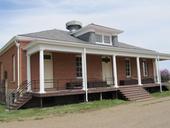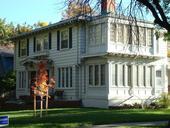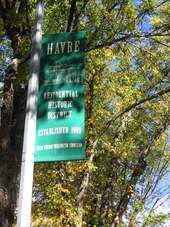Location: On Northern Montana’s "Hi-Line" Highway 2, about midway between the North Dakota and Idaho borders; 103 miles east of Shelby. Visitor Information: Havre Chamber of Commerce, 518 1st Street, PO Box 308 Havre, MT 59501; Phone: (406) 265-4383; Website: www.havrechamber.com 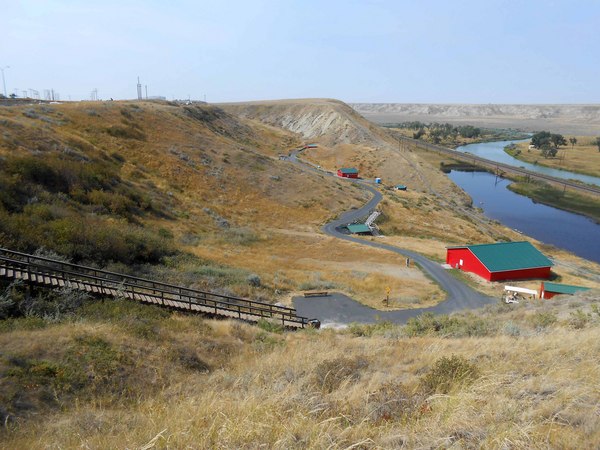
Havre is a thriving "Hi-Line" town with a population of over 10,000, making it Montana’s 8th largest city. Transformed by the railroad, agriculture and business from raw prairie and bottomland, Havre was incorporated in 1893. The town is scenically situated near the Milk River and Bear Paw Mountains and maintains 20 municipal parks with a variety of recreational amenities.
Major attractions include the H. Earl Clack Museum, Havre Beneath the Streets, the Railroad Museum, Wakpa Chu’gn Buffalo Jump, Fort Assinniboine and three local historic districts representing a residential area, downtown and railroad districts, with walking tour maps available for all.
Over 65 million years ago a large inland sea covered most of Montana, creating a semi-tropical flood plain where large herds of dinosaurs lived, migrated and nested. Many discoveries of worldwide significance have been made in Montana and along the Montana/Canada border. One such find from the Havre area, consisting of an egg nest casting of extremely rare dinosaur eggs with embryos, is on display in the H. Earl Clack Museum, as well as an infant Lambeosaur. Visitors also have a chance to touch actual fossils in the hands-on exhibit. The Museum gift shop features "Made in Montana" products, items crafted by local residents, books and children’s items. Tours are available with advance notice. Located in Holiday Village Mall the museum, hours are seasonal, with extended hours from Memorial Day through Labor Day.
Havre Beneath the Streets and the Railroad Museum are fascinating attractions providing visitors a unique glimpse into the rowdy early history of the cowboy, bootlegging and railroad town. In 1887, railroad tycoon James J. Hill started laying hundreds of miles of track across the empty expanse of North Dakota and Montana Territory. The Railroad Museum preserves that vital history with an extensive display of railroad antiques and paraphernalia. A volatile mix of railroaders, soldiers, miners and cowboys coupled with isolated location and lack of law enforcement led to the reputation as the rowdiest town in the west.
Havre Beneath the Streets recreates one of the town’s many bordellos in a space that was once a "safe house" for the Chinese, who found it wiser to stay beneath the streets at night than to deal with the prejudiced nightlife. Reports also claim the space served as a onetime "flop house" for itinerant cowboys, hobos or overly enthusiastic patrons of the Sporting Eagle Saloon. Numbers on the walls of the "bordello" indicate that 27 beds once occupied the narrow room.
Overlooking the Milk River on the northern edge of Havre, the 2,000-year-old buffalo jump Wahkpa Chu’gn is the most extensive and best-preserved buffalo bone deposit in the northern Great Plains. Visitors will see extensive Native American material and buffalo bone remains at actual archaeological excavations, where a 20-foot wall of artifacts, bones and skulls has been left in place. Three different Native American groups, differentiated by their markedly different arrowhead styles, used the kill site at various times. Extensive use by the Besant people is dated between 2000 and 1500 years ago. The Avonlea were active between about 1200 and 1300 years ago and were immediately followed by the Saddle Butte people, who continued to use the site until about 600 years ago. Tours are seasonal with extended hours from Memorial Day through Labor Day.
Located 6 miles south of Havre, Fort Assinniboine was constructed in 1879 to protect northern settlers after the battle of the Little Big Horn in 1876 and the Battle of the Bear Paws in 1877. The fort was the largest military post west of the Mississippi and was considered one of the most strategically important. Up to 600 troops were stationed in about 100 elegant brick buildings, with title to 700,000 acres encompassing all of the Bear Paw Mountains and land that would later become the Rocky Boy Reservation. Among the notable people stationed at Fort Assinniboine was a young lieutenant named John J. Pershing, who would latter rise to the rank of General and command American Expeditionary Forces in Europe during WW I; in 1898 Captain William T. Anderson became one of the first black officers to command an American military post. Tours are available M-F from 9am to 5pm and weekends from noon to 5pm. Special tours call 262-7656 or 265-4383.
Havre's Historic Districts: Historic Railroad District
In August of 1893, twenty-six peopled voted to incorporate Havre as a city on September 5 of that year. The town-site was platted south of the railroad tracks, on parts of the Descelles and Pepin ranches. Like many railroad towns, Havre’s streets were set in a grid formation, the east-west orientation of the railroad serving as the northern boundary of the town paralleled to the south by Main Street, which fronted the railroad tracks, followed by First through Third Streets. The depot served as the gateway to the commercial district of Havre.
Historic Downtown Business District
The homestead boom and creation of Hill County sparked the growth of businesses and industries. Many of Havre’s big businesses like the Havre Commercial Company, the Lou Lucke Company and the H. Earl Clack Company were located on 3rd Avenue. These companies capitalized on the large number of people arriving or passing through town. New industries and businesses continued to develop and meet the needs of the growing community. These companies expanded while cementing Havre’s place as the regional hub in northcentral Montana.
Residential Historic District The first settler in what is now Havre was John Bell, a sergeant from Fort Assinniboine. His first home was a simple log cabin. With the railroad came more settlers and they became merchants, business people, farmers, ranchers, and entrepreneurs. As their finances increased, so did the need for permanent homes and many forms of popular architecture were constructed and still proudly exist today. The Residential Historic District was placed on the National Register of Historic Places in 1989.
Free self-guided walking tour maps for Havre’s three Historic Districts are available at the Chamber office, 130 5th Avenue, or Havre/Hill County Library, 402 3rd Street.
The town of Chinook is located 21 miles east of Havre on Highway 2, where the Blaine County Museum provides an excellent introduction to the time, place and events of the Battle of the Bear Paw Mountains. Located 15 miles south of Chinook on Highway 240, the Bear Paw Battlefield marks the end of the epic 1,200-mile flight of the Nez Perce, from their homeland in northeast Oregon and southern Idaho toward their Crow allies in eastern Montana and northward to Canada. The US government voided their treaty with the Nez Perce in 1877 and attempted to coerce them onto a reservation. During ensuing negotiations a civilian shot and killed two members of the truce delegation. Thus a group of about 2900 men, women and children composed of five Indian bands began a running battle with US troops commanded by General Oliver Howard, who had appeared before Congress to contest the injustice of the treaty breach.
Five months later and about 40 miles from Canada, the Nez Perce paused to regroup before making their final trek to safety, unaware that 400 men under the command of Colonel Nelson Miles had been dispatched from southeastern Montana to intercept them. The Nez Perce endured five days of artillery and sniper fire, which began in nearly unbearable blizzard conditions, while as many as 200 women, children and accompanying warriors under chief White Bird escaped to Canada and eventual safety at Sitting Bull's camp. Chief Joseph, a peace chief who was leading the surviving Nez Perce, decided to surrender. On October 5, 1877 during the final hours of the siege, Chief Joseph issued the profound and eloquent statement for which he is justly famous: "My people: some of them have run away to the hills and have no blankets, no food, no one knows where they are; perhaps freezing to death. I want to have time to look for my children, to see how many I can find. Maybe I shall find them among the dead. Hear me my chiefs, I am tired; my heart is sick and sad. From where the sun now stands I will fight no more, forever."
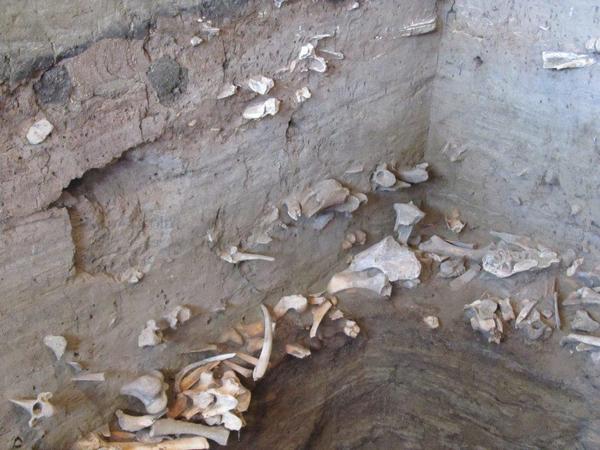  |
|



